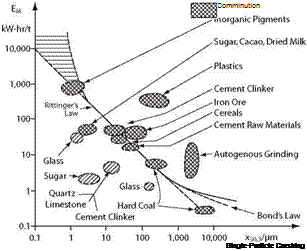Dr.-Ing Klaus Schonert studied under Rumpf at the University of Karlsruhe, where he used single-particle breakage to study comminution, studied air separators to close drygrinding circuits in cement plants, and did his early studies on HPGRs. In 1968, he became the head of the university’s comminution group (Instituterfuer Aufberetung und Veredelung). Schonert’s research at the University of Karlsruhe and later at the Technical University in Clausthal, Germany (Technische Universitat Clausthal), led to the patenting of the HPGR in 1982. He is best known for his work in developing the high-pressure double-roll crushing and grinding mill used for coarse grinding of cement clinker.
 |
FIGURE 2.2 Specific energy consumption in comminution and single-particle crushing (Rumpf 1977; reprinted by permission from Elsevier Power Technology)
Immanuel Nobel
Immanuel Nobel, Alfred’s father, was a civil engineer and inventor in Stockholm, Sweden. Immanuel’s interest in discovering a powerful explosive suitable for breaking rocks started with the excavations involved in his construction work and was fueled by plans to cut a canal at Suez, Egypt.
It was incredible how little progress had been made in the ways of canal and road building since the time of the Roman Emperors. …Mining especially needed means by which to cut faster into the subsoil. A powerful explosive that was capable of blowing up rocks at vital spots could revive the only industry worthy of the name in Sweden—the mining of iron ore. (Halasz 1959)
In 1837, Immanuel Nobel moved to St. Petersburg, where he convinced the Tsar of Russia that naval mines could protect the port from foreign warships. The resulting contract enabled him to educate his sons well and to finance Alfred’s 2-year visit to Sweden, Germany, France, and the United States in 1849-1850. In France, Alfred met Ascanio Sobrero, who had invented nitroglycerine 3 years earlier. This meeting had great consequences.
Although nitroglycerine is a very powerful explosive, its sensitivity to heat and pressure made it too dangerous to use. In St. Petersburg and then in Stockholm (to which they returned in 1863) Alfred and Immanuel systematically investigated the possibilities for making nitroglycerine safer without losing its explosive power. Their experiments involved detonating mixtures of nitroglycerine and black powder under various conditions. They concluded that the full effect of nitroglycerine as an explosive could only be obtained by detonating it with a compound, such as mercury fulminate, exploded in close proximity (Drinker 1888), and the igniter cap was born. Although the market for nitroglycerine explosives was brisk, premature explosions still occurred.
In 1867, Alfred observed that the mineral kieselguhr, which was packed around containers of liquid nitroglycerine, absorbed the explosive when it leaked. He made a mixture of 75 parts of nitroglycerine and 25 parts of kieselguhr that was solid, could be formed
into cartridges for putting into drill holes, was less sensitive than nitroglycerine, and had strong explosive properties (McAdam and Westwater 1958). He called the product dynamite and demonstrated that it could be handled safely and detonated when required. With dynamite, Nobel took blasting to another plateau of safety, efficiency, and cost, and this explosive dominated the market for 100 years. With this discovery, “The blasting of roads and mines now entered a new era, as did the military art” (Halasz 1959).
Later Nobel combined guncotton (made in 1846 by Christian Schoenbein at the University of Basle, Switzerland, by reacting nitric and sulfuric acids with cotton) with nitroglycerine to make a very powerful explosive that he called blasting gelatin. He continued experimenting and improving his explosives while building a network of manufacturing companies and marketing offices in many countries. By applying science to the formulation of explosives, he made products that changed the world. The Nobel Foundation’s Web site sums up his contributions well: “Alfred Nobel’s greatness lay in his ability to combine the penetrating mind of a scientist and inventor with the forward-looking dynamism of the industrialist” (Nobel Foundation 2004).
